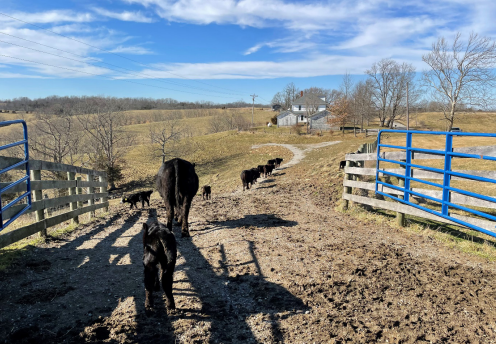|
Steve Higgins, Biosystems and Agricultural Engineering A large animal can expend tremendous energy when traveling on a slope. To compensate, grazing animals create trails that run parallel to a slope. These trails allow animals to graze the upper slope while standing on flat ground, which provides energy and grazing efficiencies (Figure 1). When cattle do this, it is colloquially known as “cowtouring,” because the trails resemble the practice of contour cropping and terracing. A second type of trail created by grazing animals, the cow path, is also designed to save energy. At approximately 12 inches in width, these singular trails are the same width as grazing trails, but there are subtle differences between them. Animals can be seen walking these trails in single file without grazing, typically using them to reach water, feed, or mineral sources efficiently. These trails may follow contours, but they may also be found on the crests of hills, in ravines, and crossing ravines to get from one hill slope to another. These trails can also be made around obstacles within a field. Common obstacles include internal corner posts, which may also demonstrate the severe erosion that can occur when grazing animals round corners (Figure 2).
Depending on the topography and weather, certain sections of these trails can become troughed or concave and may reach depths of 15 inches or more. Drainage water that collects in troughed sections of these trails can make travel difficult. Over time, certain sections of the trail may become less efficient, at which point animals will create a new path. In addition, the location of water sources or other features that animals want to reach may necessitate uphill and downhill travel on these paths. This can require a tremendous amount of effort. It may be difficult to achieve in wet weather and can be problematic, as cattle do not like to traverse slopes greater than 30 percent, while the limit for horses is 50 percent. Installing an all-weather surface such as a Mechanical Concrete path can improve energy efficiency for animals traveling along a hill slope. Mechanical Concrete is a building process that uses recycled tires and aggregate stone to create a strong and economical base. The sidewalls of used tires are first removed, leaving a tread cylinder. The ideal tread cylinder is one that has been created from a semitruck tire, because the constructed path requires a lift, or trench, of approximately eight inches. A trench depth of eight inches is needed to remove the topsoil layer and provide a rock depth suitable for supporting the weight of grazing animals. The trench can be created using a backhoe or track hoe with a 36-inch bucket (Figure 3). Figure 3. A backhoe creates a trench for the all-weather path. An actual tire cylinder may be approximately 40 inches in diameter, but the removal of the tire sidewall will enable the tire cylinder to fit within a 36-inch-wide trench. Nonwoven geotextile fabric should be placed in the bottom of the trench (Figure 4). This material is needed to provide the drainage, reinforcement, friction, and separation necessary for structural integrity. The tread cylinders are then placed end to end, on top of the geotextile fabric (Figure 4). A suitable rock material, such as dense-grade aggregate (DGA), is then placed inside and around the tire voids (Figure 5). The top edge of the tire cylinder should be at grade level or a little higher (Figure 6). The effort required to install an all-weather surface trail for grazing animals will not be wasted. Grazing animals and their offspring can be seen using these trails during all times of the year (Figure 7). These trails provide energy efficiencies for animals, particularly during wet weather periods. Summary Grazing animals will create efficient routes to acquire water, mineral, or feed. However, these trails may become difficult to travel during periods of wet weather. Erosion of the trail could also expose clay subsoil, which can become slippery, plastic, and difficult to traverse. The energy expended and drudgery experienced by a large animal traveling on a slope can be tremendous. Producers interested in providing a more effective trail should consider implementing an all-weather surface application. References
Coughenhour, M. B. 1991. Spatial Components of Plant-Herbivore Interactions in Pastoral, Ranching, and Native Ungulate Ecosystems. Journal of Range Management 44 (6), pp.530-542. Howard, J. K. and Higgins, C. G. 1987. Dimensions of GrazingStep Terracettes and their Significance. International Geomorphology. Edited by V. Gardiner. Wiley and Sons. Roath, L. R. and Krueger, W. C. 1982. Cattle Grazing and Behavior on a Forested Range. Journal of Range Management 35 (3), pp.332-338. Trimble, S. W. and Mendel, A. C. 1995. The Cow as a Geomorphic Agent – A Critical Review. Geomorphology 13 (1-4), pp.233-253. To view in original pdf format, click the link below. http://www2.ca.uky.edu/agcomm/pubs/AEN/AEN165/AEN165.pdf Comments are closed.
|
Archives
June 2024
Categories
All
Welcome |
CONTACT US |
EMAIL SIGN UP |
|
Eden Shale Farm
245 Eden Shale Rd. Office: (859) 278-0899 Owenton, KY 40359 Fax: (859) 260-2060 © 2021 Kentucky Beef Network, LLC.. All rights reserved.
|
Receive our blog updates
|









 RSS Feed
RSS Feed
